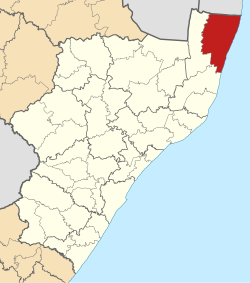
Back UMhlabuyalingana Plaaslike Munisipaliteit Afrikaans Umhlabuyalingana CEB UMhlabuyalingana Local Municipality German Municipalità locale di Umhlabuyalingana Italian Umhlabuyalingana Dutch Umhlabuyalingana Komunie, Sud Afrika NOV Mmušôgaê wa uMhlabuyalingana NSO Umhlabuyalingana Polish UMasipala wakwa Mhlabuyalingana Zulu
uMhlabuyalingana | |
|---|---|
 Location of UMhlabuyalingana Local Municipality within KwaZulu-Natal | |
| Coordinates: 27°1′S 32°44′E / 27.017°S 32.733°E | |
| Country | South Africa |
| Province | KwaZulu-Natal |
| District | uMkhanyakude |
| Seat | Kwangwanase |
| Wards | 17 |
| Government | |
| • Type | Municipal council |
| • Mayor | D. A. Ncube |
| Area | |
• Total | 3,964 km2 (1,531 sq mi) |
| Population (2011)[2] | |
• Total | 156,736 |
| • Density | 40/km2 (100/sq mi) |
| Racial makeup (2011) | |
| • Black African | 99.3% |
| • Coloured | 0.1% |
| • Indian/Asian | 0.1% |
| • White | 0.3% |
| First languages (2011) | |
| • Zulu | 95.7% |
| • English | 1.2% |
| • Southern Ndebele | 1.0% |
| • Other | 2.1% |
| Time zone | UTC+2 (SAST) |
| Municipal code | KZN271 |
uMhlabuyalingana Municipality (Zulu: UMasipala wakwa Mhlabuyalingana) is a local municipality within the uMkhanyakude District Municipality, in the northeastern part of the KwaZulu-Natal province of South Africa. The municipality is one of the poorest in the country. It encompasses a World Heritage Site and several areas under environmental protection.[4] Areas of conservation and environmental interest within or adjacent to the uMhlabuyalingana area include the Tembe Elephant Park, iSimangaliso Wetland Park (a World Heritage Site), the Suni-Ridge Sand Forest Park, and the Phongolo Nature Reserve.
The municipality was approximately 98% rural in 2001, with a population of 140,963 inhabitants according to Statistics South Africa. The municipality is made up of at least 99% Black South Africans, most of whom are isiZulu-speaking. The population is very young: 44% were younger than 15, and 77% were younger than 35 years old. Because of its youth, the population is particularly vulnerable to the impact of HIV/AIDS.[4] Towns and major settlement nodes in the area include Emanguzi, Mbazwana, Kwangwanase, Maputa, Mboza, Mseleni and Skhemelele.
- ^ "Contact list: Executive Mayors". Government Communication & Information System. Archived from the original on 14 July 2010. Retrieved 22 February 2012.
- ^ a b "Statistics by place". Statistics South Africa. Retrieved 27 September 2015.
- ^ "Statistics by place". Statistics South Africa. Retrieved 27 September 2015.
- ^ a b Integrated Development Plan 2008-2009. uMhlabuyalingana Local Municipality. Retrieved on Oct 12, 2009.
